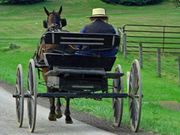Amish, Hutterite children have profound differences in proportions, phenotypes, functions of immune cells
THURSDAY, Aug. 4, 2016 (HealthDay News) — The Amish environment seems to provide protection against asthma and allergic sensitization, according to a study published in the Aug. 3 issue of the New England Journal of Medicine.
Michelle M. Stein, from the University of Chicago, and colleagues examined environmental exposures, genetic ancestry, and immune profiles among 60 Amish and Hutterite children. Levels of allergens and endotoxins were measured, and the microbiome composition of indoor dust samples was assessed. The effects of dust extracts obtained from Amish and Hutterite homes were assessed on immune and airway responses in a murine model of experimental allergic asthma.
The researchers found that the prevalence of asthma and allergic sensitization was four- and six-times as low in the Amish, despite similar genetic ancestries and lifestyles of Amish and Hutterite children; the median endotoxin levels in Amish house dust were 6.8 times as high. Amish and Hutterite homes had differences in microbial composition in dust samples. The two groups of children also had profound differences in the proportions, phenotypes, and functions of innate immune cells. Intranasal instillation of dust extracts from Amish but not Hutterite homes significantly inhibited airway hyperreactivity and eosinophilia in a mouse model of experimental allergic asthma. Mice that were deficient in MyD88 and Trif, molecules critical in innate immune signaling, had abrogated protective effects.
“The results of our studies in humans and mice indicate that the Amish environment provides protection against asthma by engaging and shaping the innate immune response,” the authors write.
Copyright © 2016 HealthDay. All rights reserved.








